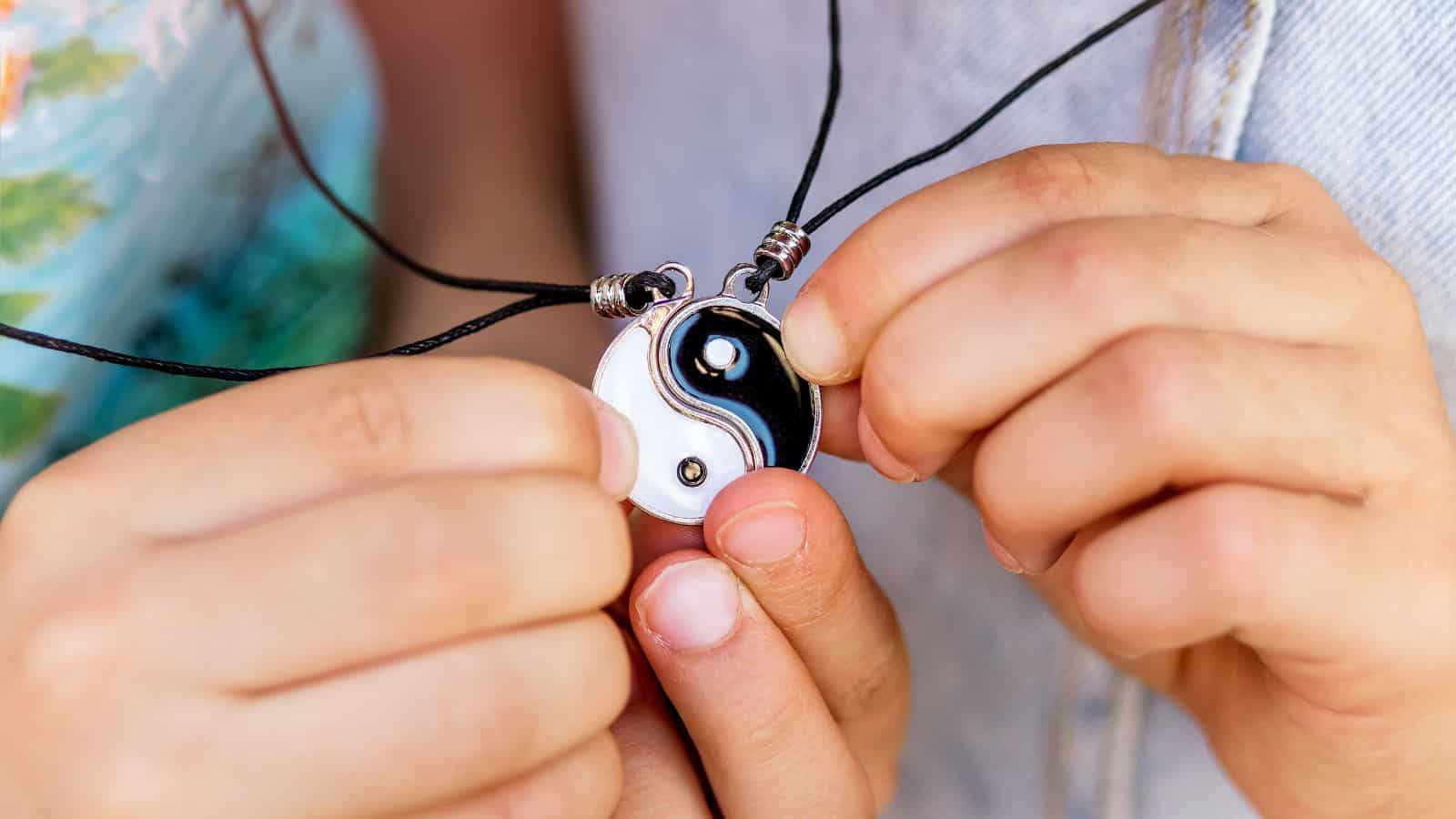Symbols are shapes, signs, or logos that have a meaning that is sometimes universally understood, but often, people are unaware of their original meaning or intention. Symbols like @ are vital to modern life and are used worldwide, but many are unaware of their origins. Here are 17 widely used symbols with meanings and origins that aren’t widely known.
Peace Symbol

The peace symbol is known by many for its widespread use in 1960s anti-war movements. But fewer people are aware of its origin. Britannica notes, “The modern peace sign was designed by Gerald Holtom for the British Campaign for Nuclear Disarmament in 1958.” It is a combination of the semaphore signals for the letters “N” and “D,” standing for “nuclear disarmament.”
Yin and Yang

The Yin and Yang symbol is instantly recognizable, but most people are unaware of its meaning. Dictionary.com defines the symbol as “two complementary principles of Chinese philosophy: Yin is negative, dark, and feminine, Yang positive, bright, and masculine.” The interaction of the two emphasizes the importance of balance in life.
Anarchy Symbol

The letter “A” in a circle can be found on graffiti worldwide, but not everyone knows its true meaning. The “A” in the circle stands for “anarchy” and was widely adopted by the punk movement in the late 20th century as a symbol of rebellion, with bands like Crass popularizing its use.
Caduceus

The Caduceus is the staff of the ancient Greek god Hermes. Two serpents wrap around the staff and are surmounted by wings. Some may understand it to be a symbol of medicine because medical organizations erroneously use it. Caduceus represents commerce, negotiation, and balance, while the single serpent of the Rod of Asclepius actually represents medicine.
Recycling Symbol

The three arrows of the recycling system folded in a möbius strip represent a closed loop, symbolizing the sustainability of recycling. Middle Tennessee State University explains the origin of the symbol as a 1970 design by university student Gary Anderson as part of a nationwide contest for the first Earth Day.
Bluetooth Symbol

Introduced in 1998, Bluetooth technology has removed the need for wires when listening to music on a speaker. While the symbol is instantly recognizable, its origin is less obvious. Creative Bloq recounts the story behind the famous logo, writing that engineers Sven Mattisson and Jim Kardach used the name of a Viking king who united Denmark and Norway, Harald Bluetooth, and superimposed “the Nordic runes for the letters H and B, for ‘Harald Bluetooth.’”
Biohazard Symbol

The biohazard symbol warns of substances that threaten human health or the environment. According to Hibiscus Plc, the symbol was “created in 1966 by Charles Baldwin, an environmental health engineer at the Dow Chemical Company,” and was designed to “clearly communicate the dangers of biological materials, such as bacteria and viruses, in a way that was easily recognizable and universally understood.”
Om Symbol

The Om symbol is an ancient representation of the sacred sound of the universe, encompassing all sounds in one. Used in various religions, it is considered one of the most important symbols in Hinduism. The symbol represents the essence of the ultimate reality, consciousness, or Atman.
Gender Symbols

The symbols for male and female are widely used, instantly recognizable, and date back to 1751. Carl Linnaeus used symbols to assign flowers as male or female and used the astrological symbols of Mars and Venus for male and female, respectively.
Infinity Symbol

Infinity is the concept of something endless, bigger than any number. The symbol of the endless loop to represent it, ∞, is the 1655 creation of English mathematician John Wallis. The symbol has been used as a logo for various corporations over the past decade.
Hazard Symbols

Hazard symbols originate from the drawings used to designate something poisonous in the early 1800s. They have since been adopted internationally to ensure consistent communication of chemical hazards. The symbols are designed to be easily recognizable and understandable to avoid exposing people to harm.
Wireless Symbol

The wireless symbol represents radio waves spreading outward, indicating the presence of a wireless network. It symbolizes ubiquitous connectivity, the global reach, and accessibility of the technology in connecting devices to the internet.
The Power Symbol

The power symbol on devices is universally understood to turn a device on or off, but the meaning behind the symbol is less understood. It represents the binary state of a device, with the line in the middle symbolizing “1” or on and the circle representing “0” or off.
The @ Symbol

The @ symbol is essential to email addresses, separating the user name from the domain name. But historically, it was used in accounting to mean “at the rate of,” for example, “12 widgets @ $1.” It has since become a symbol of the internet age, representing digital communication and connectivity.
The Question Mark

The question mark is added to the end of sentences that are questions, inquiries, or expressions of uncertainty. This essential punctuation mark in written language has a Latin origin in the late 700s and was standardized in the 1200s.
The Ampersand (&)

The ampersand, or &, evolved from the Latin word “et,” meaning “and.” Through ligature, the letters were joined to create a single glyph, with the symbol today being used in logos, company names, and branding due to its aesthetic appeal and elegant shape.
The Heart Symbol

The heart symbol is instantly recognizable as a representation of love and affection. There are numerous theories for its origin, linking it to various historical, religious, and cultural contexts, from ancient ivy leaves to the Silphium plant. It is pervasive in modern culture as a popular emoji and symbol of Valentine’s Day.
Read More: 17 Things That Are Sadly Disappearing From Everyday Life

Life in modern times seems to evolve at an unprecedented pace. Certain things we couldn’t live without a few years ago are rapidly becoming redundant. Let’s take a peek at 17 such victims of modernization and why they’re slowly but surely disappearing.
17 Things That Are Sadly Disappearing From Everyday Life
15 Ways To Tell If Someone Is Not a Good Person

While it’s important to avoid quick judgments, certain behaviors can be strong indicators of a person’s character. Here are 15 ways to discern if someone might be a bad influence or possess harmful traits.
15 Ways To Tell If Someone Is Not a Good Person
19 Untrue American Stereotypes That Are Widely Believed Internationally

Stereotypes and misconceptions can be misleading and frustrating, especially when they pertain to nationalities. Let’s explore and debunk some common myths about America, as shared by internet users.
19 Untrue American Stereotypes That Are Widely Believed Internationally
18 Everyday Items That Have Now Become Too Expensive For the Average American

There are some items that we have to pay for every single day. But for the average American, these mundane things are becoming too expensive. In this article, we will show you 18 of these pricey day-to-day items.
18 Everyday Items That Have Now Become Too Expensive For the Average American
18 Hard Truths to Accept in Life, According to Boomers

The older we become, the more we learn about life, and with that come the truths that we need to accept. Boomers have had their fair share of truths as they’ve grown through the years. Here are 18 hard truths that every boomer wants us to know.
